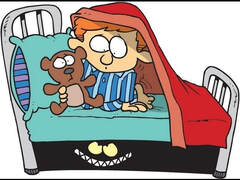
Has your child refused to participate in group activities, complain of having a stomach-ache before a new activity, lash out at others when nervous, or constantly seek reassurance that things will be okay? If so, you may be observing some behaviours that children show when they are anxious or worried.
Let’s take a moment to consider what is happening around the world currently. The Covid-19 pandemic that has spread across the nations has left many of us in panic and fear. Amidst the situation, the behaviours observed by adults around us include fear of leaving our home to do grocery shopping, worry they have symptoms, aggression at supermarkets and panic buying, and constant checking of our newsfeed. We can see some similarities exist between our own behaviour in times of fear and uncertainty and those that our children display.
All of us experience anxiety to some extent and react to it in different ways. For some people it is crippling and they may not know how to effectively manage these intense feelings of anxiety. As we can relate to the impact of anxiety in ourselves, we can also imagine how big and impactful it may be for your child who has little experience with tackling the adversity and fears in their life.
Let’s take a moment to consider what is happening around the world currently. The Covid-19 pandemic that has spread across the nations has left many of us in panic and fear. Amidst the situation, the behaviours observed by adults around us include fear of leaving our home to do grocery shopping, worry they have symptoms, aggression at supermarkets and panic buying, and constant checking of our newsfeed. We can see some similarities exist between our own behaviour in times of fear and uncertainty and those that our children display.
All of us experience anxiety to some extent and react to it in different ways. For some people it is crippling and they may not know how to effectively manage these intense feelings of anxiety. As we can relate to the impact of anxiety in ourselves, we can also imagine how big and impactful it may be for your child who has little experience with tackling the adversity and fears in their life.
During your child’s fearful moments, there are certain things you can do as a parent to help.
Let’s take a look at the following helpful strategies
Praise “brave behaviour:” You may have already heard that paying attention to a behaviour increases it, whereas paying little attention to a behaviour reduces it. This also applies to anxious behaviours. In situations where your child seems worried, it would be beneficial to pay as little attention as you can to anxious behaviours whilst acknowledging their concerns. You can do this by dealing with the situation quickly and in a calm manner (E.g. “It looks like you’re feeling worried because the work is too hard, let’s take some deep breaths and lets take a look at it together to see how you would be able to complete it”). On the contrary, praise your child’s ‘brave behaviours’ (E.g. separating from parents, participating in new activities etc), and tell them exactly what brave behaviour you noticed. This will help motivate your child and encourages them to continue that behaviour. At the same time, rewards may also encourage your child to do the behaviour again. Keep in mind to switch up the rewards so it does not lose its incentive whilst making sure it is the right size and suited to your child.
Praise “brave behaviour:” You may have already heard that paying attention to a behaviour increases it, whereas paying little attention to a behaviour reduces it. This also applies to anxious behaviours. In situations where your child seems worried, it would be beneficial to pay as little attention as you can to anxious behaviours whilst acknowledging their concerns. You can do this by dealing with the situation quickly and in a calm manner (E.g. “It looks like you’re feeling worried because the work is too hard, let’s take some deep breaths and lets take a look at it together to see how you would be able to complete it”). On the contrary, praise your child’s ‘brave behaviours’ (E.g. separating from parents, participating in new activities etc), and tell them exactly what brave behaviour you noticed. This will help motivate your child and encourages them to continue that behaviour. At the same time, rewards may also encourage your child to do the behaviour again. Keep in mind to switch up the rewards so it does not lose its incentive whilst making sure it is the right size and suited to your child.

Model “brave behaviour”: Children tend to absorb what’s around them and model certain behaviours, especially those of their parents. It will be important to model ‘brave behaviours’ to your child and also learn to work through your own anxieties in a calm way so your child does not pick up your own anxious behaviours.
Be consistent: This doesn’t just mean being consistent with your rewards or consequences; it also means that you and your partner need to try to be on the same page. It is important that both parents reward and give the same consequences for the same behaviour. On a side note, don’t forget to use clear instructions and talk about rewards and consequences with your child.
Be consistent: This doesn’t just mean being consistent with your rewards or consequences; it also means that you and your partner need to try to be on the same page. It is important that both parents reward and give the same consequences for the same behaviour. On a side note, don’t forget to use clear instructions and talk about rewards and consequences with your child.
Are you jumping in too quickly? When your child is crying or frightened, often you want to reassure them and protect them by taking over or taking them out of the stressful situation. Although this alleviates their anxiety in that moment, this unfortunately unintentionally has a negative impact in the long run as it maintains your child’s fear of the situation. Your child continues to believe that the situation is dangerous and that they can’t cope on their own. Next time your child feels anxious, try to remind yourself to step back and let them explore the world themselves. Let them stay in the situation for just a bit longer, allow them to make mistakes and, if needed, guide them to do it themselves rather than taking over.
Face fears: As avoidance can maintain your child’s fear, when possible, encourage your child to gradually “face their fears” (e.g. if they are afraid of heights, you may want to take them to the top of a one storey building, then as they become more comfortable, gradually increase the level of the building they visit until they become comfortable with it). Do remember to praise and reward your child for any attempts they make to “face their fears”. Also, keep in mind to avoid “flooding” your child with anxiety (e.g. going to the top of the tallest building on the first attempt without preparation).
Be patient and calm: Lastly, it is important to remember to be patient and calm with your child when trying to manage their anxiety. Becoming emotional may make it more frightening for your child. Can you imagine how much angrier you would get if someone started yelling at you when you’re already angry? Your child will get just as emotional, or even more, if they are being rushed or yelled at during stressful times.
Face fears: As avoidance can maintain your child’s fear, when possible, encourage your child to gradually “face their fears” (e.g. if they are afraid of heights, you may want to take them to the top of a one storey building, then as they become more comfortable, gradually increase the level of the building they visit until they become comfortable with it). Do remember to praise and reward your child for any attempts they make to “face their fears”. Also, keep in mind to avoid “flooding” your child with anxiety (e.g. going to the top of the tallest building on the first attempt without preparation).
Be patient and calm: Lastly, it is important to remember to be patient and calm with your child when trying to manage their anxiety. Becoming emotional may make it more frightening for your child. Can you imagine how much angrier you would get if someone started yelling at you when you’re already angry? Your child will get just as emotional, or even more, if they are being rushed or yelled at during stressful times.
Everyone’s progress is different and for some it may be a short journey to face their fears and for others it may be a long one. Remember that your child and yourself are trying your best. Don’t give up, stay positive, and just keep practising!
Sources
1. Dan, P, (2013). Make Your Worrier a Warrior; A Guide to Conquering Your Child’s Fears, Great Potential Press, Inc, Tucson.
2. Rapee, R.M., Lau E.X., & Kennedy S.J., (2010). Cool Little Kids Anxiety Prevention Program Parent’s Manual. Centre for Emotional Health, Macquarie University: Sydney.
1. Dan, P, (2013). Make Your Worrier a Warrior; A Guide to Conquering Your Child’s Fears, Great Potential Press, Inc, Tucson.
2. Rapee, R.M., Lau E.X., & Kennedy S.J., (2010). Cool Little Kids Anxiety Prevention Program Parent’s Manual. Centre for Emotional Health, Macquarie University: Sydney.

